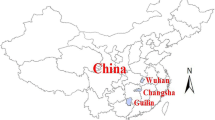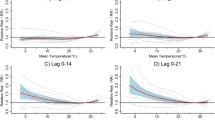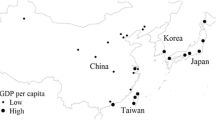Abstract
Although several studies have documented that latitude might be an effect modifier of the association between temperature and mortality, little is known about how much latitude modifies the temperature–mortality relationship. In this study, we examined this research question using a distributed lag non-linear model and meta-regression analysis based on data from 13 large cities of eastern US from the US National Morbidity, Mortality, and Air Pollution Study. We found that cold effects lasted about 1 month while hot effects were acute and short-term. Meta-regression analysis showed that latitude modified both the cold and hot effects with statistical significance. The cold effect decreased with the latitude increment, with −0.11 % change of mortality effect for 1° increment, while the hot effect increased with the latitude increment, with 0.18 % change of mortality effect for 1° increment. This finding indicates the importance of latitude on temperature-related mortality risk, which is helpful for city to develop localized effective adaptation strategy in the context of climate change.



Similar content being viewed by others
References
Analitis A, Katsouyanni K, Biggeri A, Baccini M, Forsberg B, Bisanti L, Kirchmayer U, Ballester F, Cadum E, Goodman PG, Hojs A, Sunyer J, Tiittanen P, Michelozzi P (2008) Effects of cold weather on mortality: results from 15 European cities within the PHEWE project. Am J Epidemiol 168(12):1397–1408. doi:10.1093/aje/kwn266
Anderson BG, Bell ML (2009) Weather-related mortality: how heat, cold, and heat waves affect mortality in the United States. Epidemiology 20(2):205–213. doi:10.1097/EDE.0b013e318190ee08
Anderson GB, Bell ML (2011) Heat waves in the United States: mortality risk during heat waves and effect modification by heat wave characteristics in 43 US communities. Environ Health Perspect 119(2):210–218. doi:10.1289/ehp.1002313
Armstrong B (2006) Models for the relationship between ambient temperature and daily mortality. Epidemiology 17(6):624–631. doi:10.1097/01.ede.0000239732.50999.8f
Armstrong BG, Chalabi Z, Fenn B, Hajat S, Kovats S, Milojevic A, Wilkinson P (2011) Association of mortality with high temperatures in a temperate climate: England and Wales. J Epidemiol Community Health 65(4):340–345. doi:10.1136/jech.2009.093161
Basu R (2009) High ambient temperature and mortality: a review of epidemiologic studies from 2001 to 2008. Environ Health 8:40. doi:10.1186/1476-069x-8-40
Carson C, Hajat S, Armstrong B, Wilkinson P (2006) Declining vulnerability to temperature-related mortality in London over the 20th century. Am J Epidemiol 164(1):77–84. doi:10.1093/aje/kwj147
Cheng JY, Ko JS, Chen RY, Ng EM (2008) Meta-regression analysis using latitude as moderator of paternal age related schizophrenia risk: high ambient temperature induced de novo mutations or is it related to the cold? Schizophrenia research 99(1):71–76
Curriero FC, Heiner KS, Samet JM, Zeger SL, Strug L, Patz JA (2002) Temperature and mortality in 11 cities of the eastern United States. Am J Epidemiol 155(1):80–87
Gasparrini A (2011) Distributed lag linear and non-linear models in R: the package dlnm. J Stat Softw 43(8):1–20
Gasparrini A, Armstrong B, Kenward MG (2010) Distributed lag non-linear models. Stat Med 29 (21):2224-2234. doi:10.1002/sim.3940 %/ 2010 John Wiley & Sons, Ltd.
Gasparrini A, Armstrong B, Kenward M (2012) Multivariate meta-analysis for non-linear and other multi-parameter associations. Stat Med 31(29):3821–3839
Guo Y, Barnett AG, Pan X, Yu W, Tong S (2011) The impact of temperature on mortality in Tianjin, China: a case-crossover design with a distributed lag nonlinear model. Environ Health Perspect 119(12):1719–1725. doi:10.1289/ehp.1103598
Hajat S, Kosatky T (2010) Heat-related mortality: a review and exploration of heterogeneity. J Epidemiol Commun Health 64(9):753–760. doi:10.1136/jech.2009.087999
Ibald-Mulli A, Stieber J, Wichmann H, Koenig W, Peters A (2001) Effects of air pollution on blood pressure: a population-based approach. Am J Public Health 91(4):571–577
Keatinge WR, Donaldson GC (1997) Cold exposure and winter mortality from ischaemic heart disease, cerebrovascular disease, respiratory disease, and all causes in warm and cold regions of Europe. Lancet 349(9062):1341–1346
Lin H, Zhang Y, Xu Y, Xu X, Liu T, Luo Y, Xiao J, Wu W, Ma W (2013) Temperature changes between neighboring days and mortality in summer: a distributed lag non-linear time series Analysis. PLoS One 8(6):e66403. doi:10.1371/journal.pone.0066403
Loughnan M, Nicholls N, Tapper N (2010) Mortality–temperature thresholds for ten major population centres in rural Victoria, Australia. Health Place 16(6):1287–1290
Martin SL, Cakmak S, Hebbern CA, Avramescu ML, Tremblay N (2012) Climate change and future temperature-related mortality in 15 Canadian cities. Int J Biometeorol 56(4):605–619. doi:10.1007/s00484-011-0449-y
Medina-Ramon M, Schwartz J (2007) Temperature, temperature extremes, and mortality: a study of acclimatization and effect modification in 50 United States cities. Occup Environ Med. doi:10.1136/oem.2007.033175
Ostro B, Rauch S, Green R, Malig B, Basu R (2010) The effects of temperature and use of air conditioning on hospitalizations. Am J Epidemiol 172(9):1053–1061. doi:10.1093/aje/kwq231
Patsopoulos NA, Evangelou E, Ioannidis JP (2008) Sensitivity of between-study heterogeneity in meta-analysis: proposed metrics and empirical evaluation. Int J Epidemiol 37(5):1148–1157. doi:10.1093/ije/dyn065
Ren C, Williams GM, Mengersen K, Morawska L, Tong S (2008) Does temperature modify short-term effects of ozone on total mortality in 60 large eastern US communities? An assessment using the NMMAPS data. Environ Int 34(4):451–458. doi:10.1016/j.envint.2007.10.001
Samet JM, Zeger SL, Dominici F, Curriero F, Coursac I, Dockery DW, Schwartz J, Zanobetti A (2000) The National Morbidity, Mortality, and Air Pollution Study. Part II: morbidity and mortality from air pollution in the United States. Res Rep Health Eff Inst 94(Pt 2):5–70, discussion 71-79
Turner LR, Barnett AG, Connell D, Tong S (2012) Ambient temperature and cardiorespiratory morbidity: a systematic review and meta-analysis. Epidemiology 23(4):594–606. doi:10.1097/EDE.0b013e3182572795
Viechtbauer W (2010) Conducting meta-analyses in R with the metafor package. J Stat Softw 3(36):1–48
Xie H, Yao Z, Zhang Y, Xu Y, Xu X, Liu T, Lin H, Lao X, Rutherford S, Chu C, Huang C, Baum S, Ma W (2012) Short-term effects of the 2008 cold spell on mortality in three subtropical cities in Guangdong Province, China. Environ Health Perspect 121(2):210–216. doi:10.1289/ehp.1104541
Ye X, Wolff R, Yu W, Vaneckova P, Pan X, Tong S (2012) Ambient temperature and morbidity: a review of epidemiological evidence. Environ Health Perspect 120(1):19–28. doi:10.1289/ehp.1003198
Yu W, Mengersen K, Wang X, Ye X, Guo Y, Pan X, Tong S (2012) Daily average temperature and mortality among the elderly: a meta-analysis and systematic review of epidemiological evidence. Int J Biometeorol 56(4):569–581. doi:10.1007/s00484-011-0497-3
Acknowledgments
This study was partly funded by the Special Climate Change Research Program of China Meteorological Administration (No. CCSF201211) and the Guangdong Provincial Medical Research Foundation (No. C2012030).
Competing interests
None declared.
Author information
Authors and Affiliations
Corresponding author
Additional information
Jianpeng Xiao and Ji Peng are co-first authors.
Electronic supplementary material
Below is the link to the electronic supplementary material.
Supplementary Figure S1
Relative risk of temperature on mortality by latitude for different lag period. a Cold effect, b hot effect (GIF 86 kb)
Rights and permissions
About this article
Cite this article
Xiao, J., Peng, J., Zhang, Y. et al. How much does latitude modify temperature–mortality relationship in 13 eastern US cities?. Int J Biometeorol 59, 365–372 (2015). https://doi.org/10.1007/s00484-014-0848-y
Received:
Revised:
Accepted:
Published:
Issue Date:
DOI: https://doi.org/10.1007/s00484-014-0848-y




